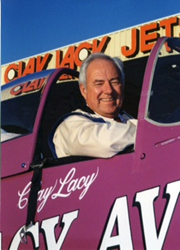“Clay Lacy is a true pioneer in so many aspects of aviation, from air-to-air shooting of Hollywood action movies through helping to establish Public Benefit Aviation,” said Mark Wolper, President & Executive Producer of The Wolper Organization at Warner Bros. and Chair of the Endeavor Awards Host Committee. “In 1965, Clay and actor, comedian and pilot Danny Kaye flew several hundred hours in a Learjet together, making charity flights to benefit the United Nations Children’s Fund. And in 1986, using his invention, Astrovision, Lacy revolutionized air-to-air cinematography, recording such action-packed aerial sequences as Paramount Pictures’ Top Gun, starring Tom Cruise.”
Clay Lacy and actor, comedian and pilot Danny Kaye flew several hundred hours in a Learjet together, making charity flights to benefit the United Nations Children’s Fund.
Growing up in the farmland of Wichita, Kansas during the Great Depression, Lacy developed an early fascination with flight. He learned how to build model airplanes at age five and created his first gasoline-powered flying model at age eight. At age 12, Lacy piloted his first aircraft at Cannonball Airport, built on his grandmother’s farm about three miles outside the city limits of Wichita, where he worked in exchange for flying time. In 1948, at age 16, he earned a flight instructor rating.
By age 19, Lacy had accumulated nearly 2,000 hours of flight time as both an instructor and ferry pilot. In January 1952, Lacy joined United Airlines as copilot on the Douglas DC-3 aircraft and was stationed at Los Angeles International Airport, where he was based for his entire airline career, including the transition from smaller propeller-driven passenger planes (like the Douglas DC-3 ‘Gooney Bird’ to giant jetliners such as the Boeing 747-400. Lacy retired seniority No. 1 in 1992 after 41½ years of incident-free flying.[6]
In 1954, Lacy took military leave from United Airlines to join the California Air National Guard at Van Nuys Airport, where he flew the F-86 Sabre jet and became the officer in charge of instrument training. He was called to active duty in 1961 for one year during the Berlin crisis, flying the C-97 Stratofreighter on missions to Japan and Vietnam, retiring from military service three years later.
In 1964, Lacy flew the first Learjet into Van Nuys Airport in proximity to Hollywood’s burgeoning entertainment industry, shaping a new era in corporate air transportation and mobility.
In 1968, he founded Clay Lacy Aviation as the first jet charter company on the West Coast, known as one of the most experienced operators of private jets in the world.
Lacy holds 29 world speed records, including a 36-hour, 54-minute, and 15-second around the world record in 1988 flying a Boeing 747SP called “Friendship One” that raised $530,000 for children’s charities.
On July 17, 2010, Lacy was inducted into the National Aviation Hall of Fame for his achievements as an aviation pioneer. On May 4, 2014, Lacy joins with the Gala Host Committee to welcome leading aviators, astronauts, Hollywood luminaries and guests celebrating Public Benefit Aviation at the Inaugural Endeavor Awards event.
About The Endeavor Awards:
The Endeavor Awards Gala is an annual event honoring the pilots, individuals and support organizations, corporations and government agencies most responsible for providing Public Benefit Aviation. Sponsoring organizations (listed below) will hold the inaugural Endeavor Awards event on May 4, 2014 at the Samuel Oschin Space Shuttle Endeavor Pavilion in the California Science Center.
Endeavor Awards Gala Sponsors:
Alaska Airlines, UCLA Health, AOPA, Tom & Mary Gallagher Foundation, Jeff & Linda Hendricks Family Foundation, Kauffman Family Foundation, JetAVIVA, Tempus Aircraft Sales & Service, King Schools, Jim & Glenys Slavik, Angel Flight West and Pacific Post.
About Public Benefit Aviation:
Public benefit flights are in the air every day across the U.S., flown by over 50 volunteer pilot organizations (VPOs). Individual pilots donate their own time, general aviation aircraft and gas money to provide health, compassion, and community service. FlightAware shows approximately 10,000 flights in 2013 identified by pilots as “compassion flights.” Exact counts of the number of flights are not yet available because many pilots do not use charity-related call signs for their flights. (Courtesy of FlightAware)

